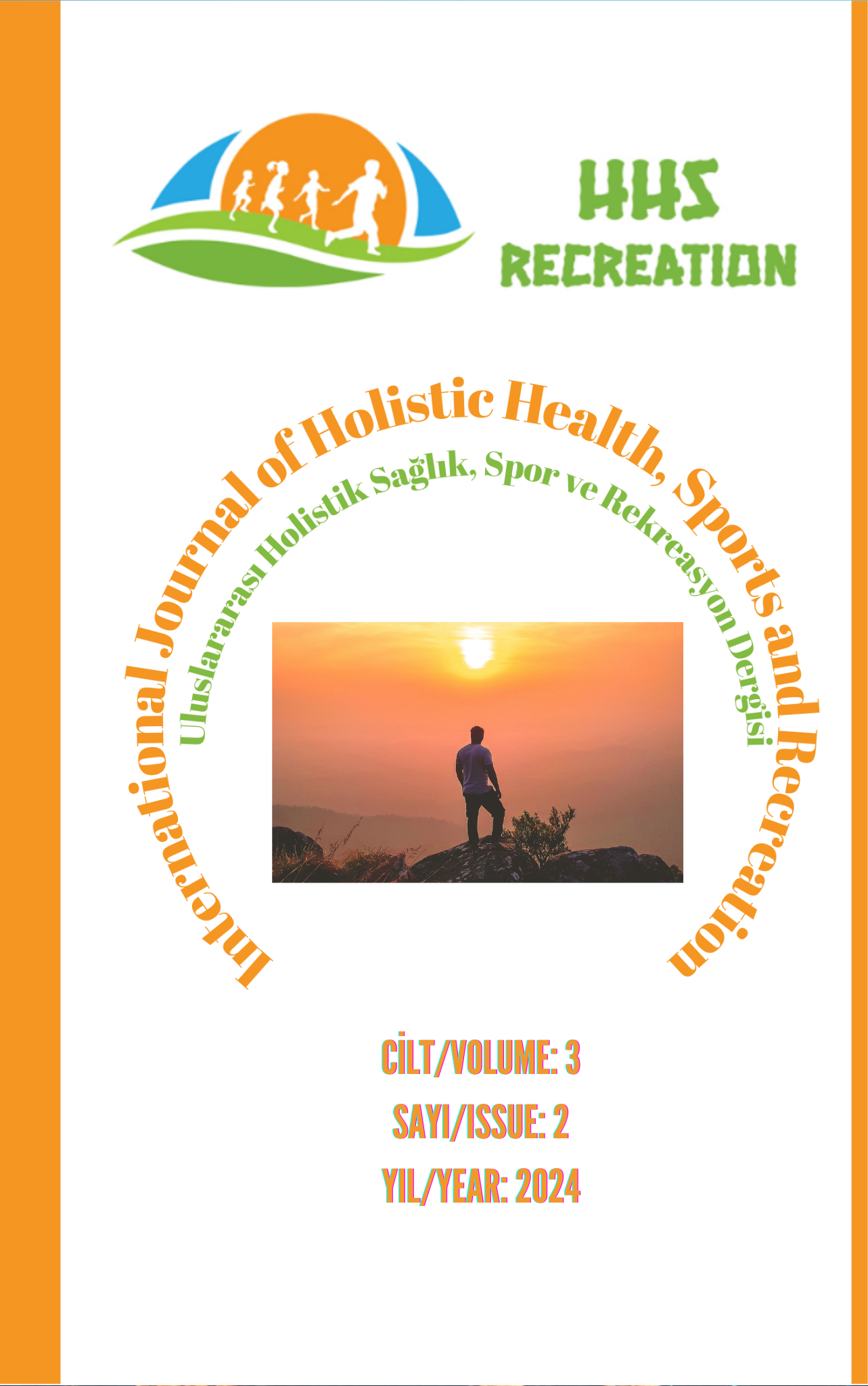The Investigation of the Effect of an 8-Week Plyometric Training Program on Agility, Speed and Balance Parameters in Sedentary Individuals Between the Ages of 10-12
DOI:
https://doi.org/10.5281/zenodo.14557033Abstract
The aim of this study was to investigate the effects of an 8-week plyometric training program on agility, speed, and balance parameters in sedentary individuals aged 10-12. Forty middle school students (10-12 years old) who volunteered to participate in the study were randomly divided into an experimental group (age: 10.9±0.8317 years, height: 141.450±10.312 cm, body weight: 40.875±5.9 kg, n:20) and a control group (age: 11±0.794 years, height: 141.950±10.431 cm, body weight: 42.4±4.499 kg, n:20). The experimental group was given a plyometric training program three times a week for 8 weeks, considering the physical and developmental characteristics of the individuals. Body mass index, body weight, agility test (t-test), flamingo balance test, 10m speed test, 20m speed test, and 30m speed test measurements were taken. When comparing the pre- and post-training performances of the groups, there was no significant difference between the experimental and control groups in terms of pre-test group body mass index (t=-2,706; p˃.05), body weight (t=-1,652; p˃.05), t-test (agility) (t=-,459; p˃.05), flamingo balance test (t=-,141; p˃.05), 10m speed test (t=-,266; p˃.05), 20m speed test (t=-,900; p˃.05), and 30m speed test (t=-,864; p˃.05) skills. When comparing the pre- and post-exercise performances of the groups, a significant difference was found between the experimental and control groups in terms of post-test group body mass index (t=-4,587; p˂.05), body weight (t=-4,099; p˂.05), t-test (agility) (t=-7,506; p˂.05), flamingo balance test (t=-5,438; p˂.05), 10m speed test (t=-3,933; p˂.05), 20m speed test (t=-4,461; p˂.05), and 30m speed test (t=-5,564; p˂.05) skills. Overall, when looking at the pre- and post-training periods, it was determined that the experimental group, which underwent a plyometric training program, developed positively. It was determined that an 8-week plyometric training program applied to sedentary individuals aged 10-12 significantly improved their agility, speed, and balance test performance. Longitudinal studies should be conducted to evaluate the long-term effects of plyometric training. Studies should be expanded to include a wider age range and gender differences. The effects of plyometric training on coordination, strength, and flexibility should also be investigated.
References
Asadi, A., Arazi, H., Young, W. B., & de Villarreal, E. S. (2016). The effects of plyometric training on change-of-direction ability: A meta-analysis. International journal of sports physiology and performance, 11(5), 563-573.
Bland, J. M., & Altman, D. G. (2011). Correlation in restricted ranges of data. Bmj, 342.
Chen, W., Hammond-Bennett, A., Hypnar, A., & Mason, S. (2018). Health-related physical fitness and physical activity in elementary school students. BMC public health, 18, 1-12.
Creswell, J. W. (2014). Research design: Qualitative, quantitative, and mixed methods approaches (4th ed.). SAGE Publications.
Mallery, P., & George, D. (2000). SPSS for windows step by step. Allyn & Bacon, Inc..
Günay, M., Tamer, K., & Cicioğlu, H., İ. (2013). Spor Fizyolojisi ve Performans Ölçümü.
Haksever, B., Düzgün, İ., Yüce, D., & Baltacı, G. (2017). Sağlıklı Bireylere Standart Denge Eğitiminin Dinamik, Statik Denge ve Fonksiyonellik Üzerine Etkileri. Gazi Sağlık Bilimleri Dergisi, 2(3), 40-49.
Hulteen, R. M., Morgan, P. J., Barnett, L. M., Stodden, D. F., & Lubans, D. R. (2018). Development of foundational movement skills: A conceptual model for physical activity across the lifespan. Sports medicine, 48, 1533-1540.
Karabulut, S., & Arkadaşları. (2021). Sedanter çocuklarda fiziksel uygunluk düzeyleri. Turkish Journal of Pediatrics, 58(3), 230-245.
Lloyd, R. S., Oliver, J. L., Faigenbaum, A. D., Howard, R., Croix, M. B. D. S., Williams, C. A., ... & Myer, G. D. (2015). Long-term athletic development-part 1: a pathway for all youth. The Journal of Strength & Conditioning Research, 29(5), 1439-1450.
Lloyd, R. S., Cronin, J. B., Faigenbaum, A. D., Haff, G. G., Howard, R., Kraemer, W. J., ... & Oliver, J. L. (2016). National Strength and Conditioning Association position statement on long-term athletic development. The Journal of Strength & Conditioning Research, 30(6), 1491-1509.
Mackenzie, B. (2005). Performance evaluation tests. London: Electric World plc, 24(25), 57-158.
Markovic, G., & Mikulic, P. (2010). Neuro-musculoskeletal and performance adaptations to lower-extremity plyometric training. Sports medicine, 40, 859-895.
Meylan, C., & Malatesta, D. (2009). Effects of in-season plyometric training within soccer practice on explosive actions of young players. The Journal of Strength & Conditioning Research, 23(9), 2605-2613.
Moran, J., Ramirez-Campillo, R., Liew, B., Chaabene, H., Behm, D. G., García-Hermoso, A., ... & Granacher, U. (2021). Effects of vertically and horizontally orientated plyometric training on physical performance: A meta-analytical comparison. Sports Medicine, 51, 65-79.
Myer, G. D., Faigenbaum, A. D., Ford, K. R., Best, T. M., Bergeron, M. F., & Hewett, T. E. (2011). When to initiate integrative neuromuscular training to reduce sports-related injuries and enhance health in youth? Current sports medicine reports, 10(3), 155-166.
Özgül, B. (2016). Çocukluk Döneminde Fiziksel Aktivite. Turkiye Klinikleri Physiotherapy and Rehabilitation-Special Topics, 2(1), 87-93.
Ramirez-Campillo, R., García-de-Alcaraz, A., Chaabene, H., Moran, J., Negra, Y., & Granacher, U. (2021). Effects of plyometric jump training on physical fitness in amateur and professional volleyball: a meta-analysis. Frontiers in Physiology, 12, 636140.
Sağlık Bakanlığı. (2022). Türkiye Fiziksel Aktivite Raporu. https://saglik.gov.tr
Semenick, D. (1990). Tests and measurements: The T-test. Strength & Conditioning Journal, 12(1), 36-37.
Tsigilis, N., Douda, H., & Tokmakidis, S. P. (2002). Test-retest reliability of the Eurofit test battery administered to university students. Perceptual and motor skills, 95(3_suppl), 1295-1300.
World Health Organization (WHO). (2020). Global recommendations on physical activity for health. Geneva: WHO Press.
Yılmaz, E., Yılmaz, S., & Aydın, Y. (2022). İlkokul çağındaki çocuklarda fiziksel aktivite düzeylerinin ve obezite ile ilişkisinin incelenmesi. Ege Üniversitesi Spor Bilimleri Dergisi, 32(2), 265-274.
Downloads
Published
How to Cite
Issue
Section
License
Copyright (c) 2024 International Journal of Holistic Health, Sports and Recreation

This work is licensed under a Creative Commons Attribution 4.0 International License.



